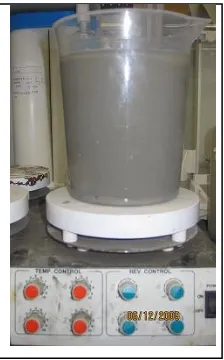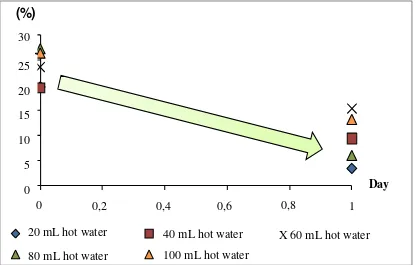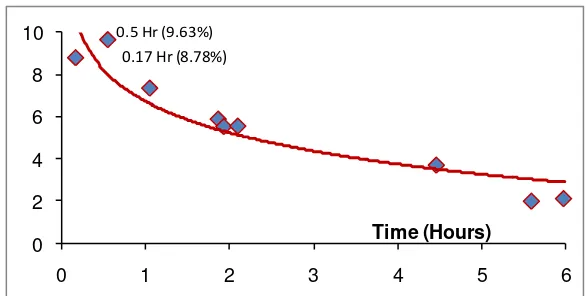LEACHABLE BORON FROM FLY ASH
KANDUNGAN BORON PADA PELINDIAN ABU TERBANG
Januarti Jaya EkaputriJurusan Teknik Sipil, Fakultas Teknik Sipil dan Perencanaan Institut Teknologi Sepuluh Nopember Surabaya
Jl. Arief Rahman Hakim, Sukolilo, Surabaya 60111 *e-mail:januarti@ce.its.ac.id
Abstract
An experimentally observation was conducted to determine boron in fly ash with Inductively Coupled Plasma Spectrometry (ICPS). Sample of solution from fly ash mixed with distilled water was analyzed for pH, agitation time, boron concentration and temperature. It was revealed that fly ash released soluble boron rapidly about 25%-30% from total boron content. Desorption of boron ions occurred afterwards. After immersion in more than one day, sorption of boron by fly ash increased with increasing pH, up to 13. The equilibrium state transpires after fly ash contact with water. Aluminum borates may release soluble boron to the solution while alkalinity of fly ash is believed to lead particles on fly ash surface to capture boron ions.
Keywords:boron, leaching, fly ash, desorption
Abstrak
Penelitian dilakukan untuk menentukan kandungan boron dalam abu terbang dengan Inductively Coupled Plasma Spectrometry (ICPS). Larutan fly ash dicampur dengan akuades kemudian dianalisis pH, waktu agitasi, konsentrasi boron, dan suhu. Terbukti bahwa abu terbang ditambah boron dapat cepat larut, yaitu sekitar 25%-30% dari kandungan boron total. Desorpsi ion boron terjadi sesudahnya. Setelah direndam lebih dari satu hari, penyerapan boron oleh fly ash meningkat sejalan dengan meningkatnya pH hingga 13. Keadaan ekuilibrium berubah setelah abu terbang kontak dengan air. Aluminium borat dapat melepaskan boron terlarut, sedangkan alkalinitas fly ash diyakini dapat membuat ion partikel pada permukaan fly ash mengikat boron.
Keywords: boron, pencucian, fly ash, desorpsi
1. INTRODUCTION
Fly ash is used in a small amount to the application in cement industry and soil treatment, structure improvement, or as plant manure while a huge amount of fly ash is just disposed on landfill. Misconduct of dumping fly ash in ponds has caused some problems. Heavy metal content in fly ash may easily seep to the underground water near the power plants. However, leaching of these contaminants to biosphere, when fly ash comes into contact with water, is not well documented in literatures.
Even though boron is not a major substance in fly ash and the fact that soils need fly ash as a
44 Jurnal Purifikasi, Vol. 12, No. 2, Juli 2011: 43-52
from the experimental result to a fundamental approach for macro scale (Ekaputri, 2011).
In this paper, fly ash samples were dissolved with de-ionized water and boron concen-tration was then measured in time depending on water contact with fly ash. Boron ion concentration as determined with ICPS (Inductively Coupled Plasma Spec-trometry) which is useful for the analysis of aqueous solution (Pougnett and Orren, 1986). Specimens were varied based on fly ash weight and its composition with water or hot water. A pH of solution was also observed to investigate the effect of solution alkalinity to soluble boron released from fly ash. The samples were simply observed in laboratory scale. They were mixed with de-ionized water for determination of boron concentration. The results were then combined with the pH
Boron is known to be a trace nutrient found in various elements in plant. It plays a great role in promoting good health and metabolism for human, animals and plants. It is found in the soil and water in many compounds. In human body and animals, its highest concentration is found in the bones. In plants, usually it is concentrated in leaf tissues. The ash which can stick on the surface of plants causes physical and metabolism injuries.
The presence of boron in drinking water source is essential to be monitored as listed in Table 1. For human, an intake of 1-2 mg per day is suggested for dietary allowance. Overdose and toxicity may occur subjected to higher levels at more than a dose 10 mg per day. Boron toxicity to human may cause dehydration, seizures, low red blood cell count and kidney or liver damage (Diaconu, 2008).
Table 1. Boron concentration in drinking water (mg/L) taken from Diaconu (2008)
WHO Eropean Community (EU Directive 98/83/EC)
USA Canada (CCREM 1987)
Australia Romania Japan (EQS)
0.5 1 1 5.0 0.3 1 1
In addition, it is not only distributed naturally in soils, sources of boron are reportedly found in regions with low rainfall, surface mining, fly ash pond generated by power plants and manufactures (Nable, Banuelos and Paull, 1997). In soils, boron toxicity is found in many soil types in level 0.5-5 mg/kg (James, 1982). Nevertheless, boron concentrations in the soil are considered critical levels for toxicity: 5 mg/L extracted by hot water, 4 mg/kg extracted with 0.05M HCl, and 2.5 mg/L in the soil solution.
Alkalinity of fly ash, caused by its contents of CaO, MgO, K2O and Na2O has a pH in the range of 8-12 (Wong, Jiang and Su, 1997). Majority, boron found in nature as borates
and boric acid, which are soluble in room temperature. Borosilicate and other non-soluble compounds may be found in high temperature.
Ekaputri, Lecheable Boron from Fly Ash 45
and Misopolinos, 2006). Once soils have been loaded with accumulated boron, complicated solutions are required such as soil reclamation, leaching boron ion with excessive water or pre-treatment with tolerant plants (Nable, 1997).
Boron Sorption Phenomena in Fly Ash
In general, boron concentration in fly ash samples widely ranges from 100 to 600 mg/kg depending upon the area which is mined. Release of boron from fly ash was correlated with the solubility behavior of Ca and Mg. Borates in dissolve fly ash contained Ca, Na and Mg is unstable. Fly ash releases soluble boron, which is believed as borates less than one day after fly ash contact with water.
Keren et al (1981) based their assumption thatB(OH)3, B(OH)-4, and OH- participate
in B sorption having different affinities for the sorbent, and compete for the same sorption sites, while the sorption capacity of the sorbent is pH dependent. In an alkali medium, boron released from fly ash their experiment using acidity and alkalinity soil, boron sorbed in alkaline soil was higher than in acid soil. Consequently, boron was easily released from fly ash into soil. However, contribution of fly ash to soils could not increase the binding strength of soil in retaining boron.
Soluble boron released and capture again by fly ash is pH dependent. After releasing, leachable boron decreases due to adsorption by fly ash. Adsorption of boron by ash increases as pH values increase from 7 to 12. Hollis et al (1988) found that dissolution of boron depended on the dissolution of calcium contained in fly ash. In fly ash suspension, soluble boron was re-adsorption by fly ash in alkaline condition. Some minerals contained in fly ash play a great role to capture released boron ion. Amorphous minerals containing aluminum is one of the hydroxyl groups, compounds are reactive surface hydroxyl groups on oxides and clay minerals.
46 Jurnal Purifikasi, Vol. 12, No. 2, Juli 2011: 43-52
2. METHODS
A class fly ash having 2.33 g/cm3 of density, Blaine surface area of 3660 cm2/g, average particle size of 19μm and pH 9.9 adopted in this study was obtained from Sapporo, Japan. Its chemical composition and toxic substances are listed in Table 2 and Table 3 respectively.
Generally, boron in soils is divided into three categories as total boron, acid soluble boron and water soluble boron (Sah and Brown, 1997). Samples were transformed (digested) to a liquid state. In this experiment, a sample of 10 g fly ash was prepared and mixed with distilled water to form a suspension as illustrated in Figure 2.
The use of laboratory glass ware which may contain borosilicate is avoided as much as possible. Some glass tubes are indicated to contribute boron leaching mixed with boron containing in fly ash. Therefore,
polypropylene-based containers were used for the experiment.
Hot water was used to investigate the effect of the temperature increase. The aqeuous suspension was put on the hotter plate for 5 minutes with refluxing and steering. The temperature of suspension was 70oC to 80oC. After steering the suspension was then filtered before ICP analysis using filter paper. The solution was kept in a plastic container until analyzed with ICP for boron determination. ICP analysis was conducted with ICPS -7000 version 2. The wavelengths used for boron analysis were 249.77 nm and 249.68 nm. A 1000 g/l boron standard solution was prepared in some concentration for ICP analysis. Distilled water was used for dilution to avoid contaminants during measurement. Distilled water was also used as a blank concentration in between two samples. Boron leaching from samples was calculated from Equation (2) as follows:
% 100 B(mg/kg) (g)
Sample
Water(gr) B(mg/kg)
(%)
B
(2)
B (mg/kg) is obtained from ICPS test, the amount of de-ionized water as the Water (g),
sample is the amount of fly ash and initial boron contained in fly ash is 120 mg/kg.
Table 2. Chemical composition of source materials
Oxide (%)
SiO2 Al2O3 Fe2O3 CaO MgO Na2O K2O TiO2 MnO2 SO3 LOI
59.5 22.84 6.33 2.44 0.96 0.02 1.63 1.14 0.08 0.21 1.0
Table 3. Toxic substances in fly ash adopted
Element Chrom 6+ Arsenic Fluorine Boron Selenium
Ekaputri, Lecheable Boron from Fly Ash 47
Figure2. Fly Ash and Distilled Water is Stirred.
3. RESULTS AND DISCUSSION
Figure 3 shows a relation between pH and boron concentration of some solution extracted from 100 g of fly ash as
compared with boron standard solution. The pH in this solution is relatively stable at 7.5 - 8 in various concentrations. Solution extracts of fly ash mixed with water has comparatively higher pH than the standard solutions.
6 6.5 7 7.5 8 8.5 9
0 10 20 30 40
pH
Boron Concentration (mg/kg)
Boron Standard Solution
FA 100 gram in solvent (without immersion)
FA 100 gram in solvent (2 days immersion)
FA 100 gram in solvent (2 days immersion+hot water)
Figure3. Relation of pH and Boron Concentration in Some Conditions.
After being kept in 2 days, the pH of solutions decreased. It occurred also if the solution is mixed with hot water. Soaking the fly ash is believed to form precipitation of some alkalis with another compound. Furthermore, increasing temperature of solution will not increase the pH since the product of precipitation is thought to be the stable salts.
48 Jurnal Purifikasi, Vol. 12, No. 2, Juli 2011: 43-52
boron increases. In lower concentration of solution, where water is more added, the pH of solution extracts decrease. Decreasing of pH of the solution will increase the extractability of boron where the competition of positive ions of alkali is lower, which may not precipitate with boron ions.
After high temperature treatment in one day equilibration, leachable boron reduced. It is necessary to agree that an increase of temperature cannot elevate boron leaching from fly ash. A possible reason is a re-crystallization of metallic oxides may induce covering of the cell
formation. In this phase, boron ions are encapsulated (James, 1982). Sorption of boron ion by the ash particle increase in immersion time prolonged.
Boron ion is captured again in one day after fly ash contact to water as illustrated in Figure 5. It is also supported by the data of pH measurement afterward as given in Figure 6. Sorption of boron increases with an increase of pH of solution in normal temperature or high temperature. Directly, after contact with water, fly ash releases more boron ions in the alkali system, starting at pH 9. After immersion in more than one day, sorption of boron by fly ash increased with increasing pH, up to 13 as described also in Figure 7.
0
5
10
15
20
25
30
0
0.2
0.4
0.6
0.8
1
(%)
day
20mL hot water
40mL hot water
60mL hot water
80mL hot water
100mL hot water
Figure 4. Boron Leaching in Some Amount of Hot Water.
The same phenomena were also found when fly ash was mixed with hot water. Hollis (1988) reported that boron ion can be captured again by fly ash with two possibili-
ties: (1) ligand exchange with the hydroxyl groups of oxides contained in fly ash and (2) precipitation of boron with CaCO3. Another
possibility is the boron ion may precipitate 30
25
20
15
10
5
0
0 0,2 0,4 0,6 0,8 1
20 mL hot water 40 mL hot water
80 mL hot water 100 mL hot water
X 60 mL hot water 1
Ekaputri, Lecheable Boron from Fly Ash 49
may precipitate with sodium to form sodium borates. As pH of the system increases, the activity of B(OH)-4 also increases, with a
corresponding increase in boron sorption capacity.
0 5 10 15 20 25
0 1 2 3 4
(%)
days
20 mL water 40mL water 60mL water 80mL water 100mL water
Figure5. Boron Leaching in Time.
0 10 20 30
9 10 11 12 13 14
(%
)
o
f
T
o
ta
l
B
i
n
F
A
pH
0 day hot water 0-day 1-day 2days 3days 4 days
for
Figure6. Boron Leaching in Alkali System.
11 11.5 12 12.5 13 13.5
0 1 2 3 4
(days)
20m l water 40m L water 60m L water 80m L water 100m L water
Figure7. The pH of Solution Extracts after Equilibrium Time.
20 mL water 80 mL water
40 mL water 100 mL water
60 mL water (Days) 13,5
13
12,5 12
11,5
11
50 Jurnal Purifikasi, Vol. 12, No. 2, Juli 2011: 43-52
0.17 Hr (8.78%) 0.5 Hr (9.63%)
0 2 4 6 8 10
0 1 2 3 4 5 6
Time (Hours)
Figure8. Boron Released from Fly Ash in Six Hours.
11.1 11.3 11.5
0 2 4 6
pH
Time (Hours)
Figure9. The pH of Solution Extracts after Equilibrium Time in Six Hours.
In average, boron released by fly ash is about 30% from total boron content in hot water and about 25% in normal water. About less than 50% of this amount will be still in the soluble form while the remaining was absorbed by fly ash particles if the contact time of fly ash with water is more than one day.
Figure 8 presents boron leaching in six hours after fly ash contact with water and the pH of solution is given in Figure 9. The amount of boron liberated from fly ash was the highest at 30 minutes about 10% from the total amount. The suspension pH has a tendency to increase as the contact with water is prolonged.
It is also important to note that at the early age of boron release, pH of solution increases. According to Equation (1), at high pH, value of borate anions is dominant. At the same time
until one day of equilibrium time, boron desorption starts. So, precipitation may occur by calcium and aluminum oxides at high pH values (Ozturk and Kavak, 2005). This causes the amount of leachable boron does not change appreciably.
4. CONCLUSION
The leaching of boron occured in the alkaline medium, where the pH was higher than 9. It occured rapidly up to one day after fly ash was in contact with water. The boron ion was absorbed again by the particles of fly ash up to pH 13, where the interaction between boron ions and calcium or sodium formed a precipitation.
Additional water to the system might increase the leaching of boron from fly ash by decreasing pH of solution resulting in
Ekaputri, Lecheable Boron from Fly Ash 51
reducing of positive charge of alkali compete in suspension. Boron ions release was about aluminum boron carbide consisted of soluble boron. Boron sorption and desorption in fly ash were strongly correlated with oxides content in fly ash, soluble boron content, pH of fly ash, the exchange capacity of cation in fly ash and the extracting of solution.
REFERENCES
Diaconu, D., Nastase1 V., Nănău, M., Nechifor, O. and Nechifor, E. (2008). Estimation of Boron Concentration in some Drinking Water Samples of Rural Environ. Qual. 35. 2222-2228.
Food and Fertilizer Technology Center (2001). Food and Fertilizer Technology Center for the Asian and Pacific Region. Taiwan.
Goldberg, S., Suarez, D.L. and Shouse P.J. (2008). Influence of Soil Salinity on Boron Adsorption by Soils. Soil Science, 173. 368-374.
Hollis, J. F., Keren, R. and Gal, M., J. (1988). Boron Release and Sorption by Fly Ash as Affected by pH and Particle Size. J. Environ. Qual. 17. 181-184.
James, W. D. (1982). Water Leachable Boron
from Coal Ashes.Environ. Science Technology. 16. 195.
Keren R and Bingham F T (1985). Boron in Water, Soils, and plants. Adv. Soil Sci. I, 1985, 229-276.
Lee, S. B., Lee, Y.B., Lee, C. H., Hong, G. O., Kim, P. J., Chan Yu (2008). Characteristics of Boron Accumulation by Fly Ash Application in Paddy Soil. Bioresource Tech. 99, 5928-5932.
Matsi T. and Keramidas, V. Z. (2001). Alkaline Fly Ash Effects on Boron Sorption and Desorption in Soils. Soil Science Society of America Journal. 65. 1101-1108.
Nable, R. O., Banuelos G. S. and Paull, J. G. (1997). Boron Toxicity. Plant and Soil, 193, 181-198.
Ozturk, Nese and Kavak, Duygu (2005). Adsorption of Boron from Aqueous Solutions using Fly Ash: Batch and column studies. Journal of Hazardous Materials. B127, 81–88,
Pougnett M. A. B. and Orren M. J. (1986). The Determination of Boron by Inductively Coupled Plasma Atomic Emission Spectroscopy. Part 1: Method Development.
Int. J. Environ. Anal. Chem. 24. 253 – 265.
Sah R.N. and Brown P.H (1997). Techniques for Boron Determination and their Application to the Analysis of Plant and Soil Samples. Plant and Soil. 193 (2). 15-33.
Topac, F. O., Baskaya, H.S. and Alkan, U. (2008). The Effects of Fly Ash Incorporation on some Available Nutrient contents of Wastewater Sludges. Bioresource Techn. 99. 1057-1065.
52 Jurnal Purifikasi, Vol. 12, No. 2, Juli 2011: 43-52
106,137-147.
Ekaputri, Januarti Jaya and Maekawa, Koichi (2011). Leaching and Adsorption mode-




